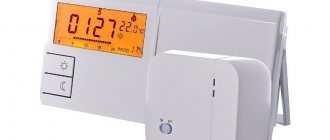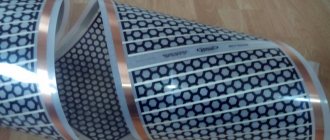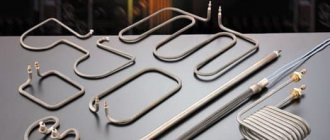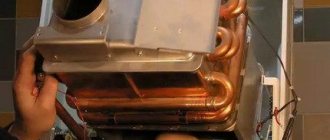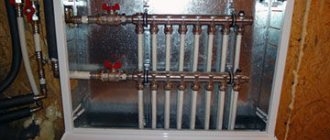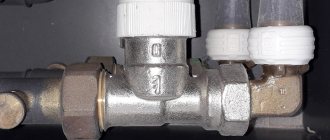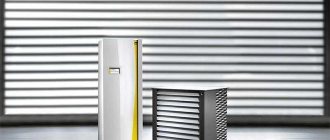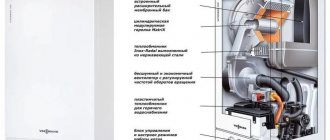To create a normal temperature regime in everyday life and at work, various types of heating devices are used. Depending on the installation location, they can be either temporary or permanent, and according to the principle of operation they are divided into convection and infrared. Convection models are classic and have been used by mankind since time immemorial, but today their use is not always advisable. Therefore, an infrared gas heater, which has significant advantages, is increasingly used to heat rooms.
Purpose
The main purpose of an infrared heater is to expose any absorbing surface to the rays it produces. Such surfaces include any objects around you that absorb light energy, that is, not transparent and the person himself. Due to this property, heating of the surrounding air space is a side effect of the operation of an infrared heater, when thermal energy from heated objects is transferred to the air. This determines the main advantage over classical systems - direct impact on a specific area and the absence of such large losses.
Rice. 1: fundamental difference in heating
In practice, an infrared gas heater is designed to heat any space in places where it is not possible to connect electric convectors to the network or where power supply is impractical.
As specific examples, an IR heater can be used for:
- Heating of gazebos and tables in nature, in park areas and recreation areas, etc.;
- Heating tents in the cold season from a gas cylinder;
- Heating garages to ensure comfortable working conditions;
- Heating of residential premises in summer cottages;
- Ensuring temperature conditions in the working area of industrial premises;
- Heating of greenhouses, chicken coops and nurseries for livestock;
- Heating any area in the open air (at construction sites, quarries, geological exploration sites, terraces, etc.).
Also, using this type of gas heaters, various surfaces can be dried and heated. An important advantage of an infrared gas heater is the use of a special element for burning fuel and producing infrared radiation. This feature makes its operation identical to that of electrical appliances, with the difference that it can function regardless of the presence of a centralized fuel source.
Customer Reviews
Sergey Aleksandrovich
Ballu BIGH-55
Pros: Convenient. Disadvantages: Haven't found it yet Comment: I ordered the heater on Yandex. It was packed well. Maybe the design of the rear limit panel fastening has been corrected. But there were no problems. The lower screws are easy to put on, but the upper ones are already accessible and easy to tighten. First launch - 10 minutes. This is logical - after all, you need to put air from a cylinder (I had a new one). The instructions are conveniently attached to the top. Everything is basically clear. I realized that the first mode switches to the second or immediately to the third. From the second to the third it does not flare up. When purchasing, I did not expect a miracle from the heater. I need it to quickly heat the room while we heat the main stove in the morning. Since it gets warm quickly, we have a warm morning. As soon as the main one heats up, turn off the heater. Because I think that gas consumption will not be significant. I also put a heater in the hallway (it’s cold here), direct it to the shower room and it becomes warm there. So for those who need fast, local, mobile heat, I recommend purchasing it.
Alexander Tyapkin
Bartolini Pullover I
Advantages: Appearance, compactness, easy to move and connect. Disadvantages: Smells of gas during the entire combustion Comment: In general, I am satisfied with this gas heater, it heats very well and does not waste electricity, but due to the smell of gas it is not at all comfortable (I only use it at maximum power so that it works less time, literally until the stove has warmed up, heating it for more than a couple of hours a day is problematic, and ventilating it while heating is pointless, in general, a vicious circle. A specific thing, I’m a little disappointed, it seems that we didn’t manage to save much on electricity as a result. PS As a result, there was a strong smell gas hose, when they changed the smell decreased, but remained.
Elena E.
Bartolini Pullover I
Super heater! On the 1st plate there is no smell of gas at all, on the 2nd plate there is just a little smell, on the 3rd plate the smell of gas is very obvious, but if the room is ventilated or there is ventilation, then this is the best solution for how to quickly heat a paddock house or something similar without consuming a lot of electricity Advantages: External appearance, compactness, easy to move and connect. Disadvantages: None Comment: The fireplace is nice, easy connection, no problems moving around the house. Heats 80 m2 without problems, we maintain the temperature at minimum. Almost silent. My parents (retired people) are very happy, it turned out to be easy to use for them, which is very important for me))) not to waste time on unnecessary explanations))). Placed in the hallway at the entrance, the heat is distributed throughout the house.
Vladimir Shmoilov
Ballu BIGH-55
Advantages: For summer residents, this is the best purchase, we bought it to heat the kitchen (attached to the house and is located outside the heating zone of the main stove), it was tested this winter (if it was winter), even in mode 1 it holds heat well, warms up to full 20 m\2. in 20-30 minutes. Disadvantages: Very long first start-up. Those who decide to buy and use it, don’t be alarmed, it took me 40 minutes to start completely the first time, but after the ceramics were completely calcined, subsequent starts were very fast. And even when installing a 27 liter gas cylinder inside. There is a bar that fixes the cylinder, so keep in mind that to fix it in place with screws you need a short Phillips screwdriver and thin hands. Comment: I advise you to write about the smell; in my opinion, the smell of gas from a gas stove for 30-40 seconds at startup is not critical.
Alexey Borisov
Ballu BIGH-3
Pros: Very powerful. Folds compactly. The kit includes a gearbox (not made in China) and an oak hose. Disadvantages: There is no regulator or just gas shutoff. Comment: The reducer is not suitable for classic metal cylinders, but for composite cylinders, they need their own reducer. The cylinder is standing outside, you have to turn on the reducer and run (well, walk quickly) into the tent to light the gas that is already coming from the stove. In my opinion, it would be better, instead of a reducer, to shut off the emergency gas on the heater or nearby. I sleep in a tent with him, ventilation and carbon monoxide detectors are required. I heat the kettle on it. But it is imperative that the kettle or pan does not completely cover the entire surface; it is better to move it not too much so that there is access to fresh air, because. The flame starts to burn less brightly and the gas burns out, and the CO sensors immediately go off.
Alexander Nezvidsky
Solar gas GII 2.9
This heater heats just like a big expensive one, because the area of the ceramics and the gas outlet are the same, the whole difference is in the design and configuration, this heater does not have a gearbox (300-500) rubles and a hose 200 rubles, a regular gas one is suitable (one end We cut off the other one onto the gearbox and pull it onto the heater nozzle, I recommend squeezing it with a clamp for those especially nervous, although everything fits tightly anyway) it’s ready. The CO2 output is minimal and is safe with natural ventilation. I’m heating the garage, in an hour I can heat up 18 m/² to plus 16 with 0 outside the gate. Another 2 kW of wind helps with it in an hour 20 plus at 14 minus outside, it will still depend on the energy efficiency of your room, if you cannot achieve such indicators, think about insulating the room. By consumption: 18 liter composite cylinder with 14 liters of refill, enough for a week when using the heater 5-6 hours a day. Refilling 14 liters costs 430 rubles.
Alexey K.
Ballu BOGH-15E
Advantages: Well made in appearance, moderately beautiful, while new, easy to light, good lighting, has a heating effect up to +12-15, moves quite easily on wheels. Remote controller. Disadvantages: At temperatures below 12, it rather serves a decorative function. Well, you can still stand close to him to warm up. Moisture protection only IP44, i.e. You can’t leave it outside without a roof, which is strange for an outdoor heater. It rusts quickly - only a few parts are stainless steel (frame and canopy), everything else is painted/galvanized. When moving on paving stones, it rattles loudly at every joint. You need to additionally buy a cylinder (a normal one costs 8 thousand) + a cover (4 thousand). Unstable with the cover on! With a small gust of wind, he fell on his side. Comment: In general, I have long wanted such a device to extend the warm season. And I took the version with a remote control so that members of the household could easily turn it on. The fire looks impressive, it’s comfortable to sit next to it, the warmth is felt at 2.5-3 meters at +20, at +15 and below - you need to sit very close or wear clothes appropriate for the weather.. A 25 liter cylinder is filled with 20 liters of gas, but in fact, when there are 5 liters left in the cylinder, the flame becomes very small even in max mode. 15 liters at maximum (and less - purely for lighting only) mode is approximately 8 hours of work. I don't have a canopy - so it needs to be covered with a cover every time, and in the cover it is unstable even with a full gas tank. And a fall on the paving stones will most likely be fatal for him. The problem is serious: it must either be tied or screwed to the floor. In addition, the device rusts and, if you do not exclude moisture, it will rust anyway. People's grilles rust completely within a year. Rust begins to ooze from the joints (where the galvanizing/painting is damaged during assembly) after the first rain. Even during the selection process, it was difficult to find information why BOGH-15E costs 15 thousand more than BOGH-15. I answer - in 15E there is electronic control of the burner, i.e. ignition and adjustment of the flame - using buttons (on the block or from the remote control), at 15 - just turn the gas supply knob and press the piezoelectric element button to ignite. Essentially, this is a device for commercial use. There is a wow effect for guests. PS. The reviews all around are clearly custom-made. Everywhere there is a list of “advantages” from the instructions (such as fall protection, cold grille, sharp edges that cut your hands during assembly, heating at 2.5 meters, etc.). But still, the device is cool and if this is not the last 60 thousand in your life, buy it!
Zhenya M.
Ballu BIGH-3
Advantages: independent of electricity. Compact and lightweight. You can power it from the cylinder or from the main line, just replace the jets. Enamel with heat-resistant coating. Power is regulated smoothly. Disadvantages: none identified yet Comment: We often go hunting and fishing with friends. I bought this useful heater and now I won’t part with it. When assembled, it doesn’t even take up much space in the trunk. I easily used it to warm a tent and a room at the dacha when it was cold. It doesn't use a lot of gas. We cooked fish soup on it more than once and made coffee in the morning. The burner is made of ceramic, it is not afraid of water. A thermocouple is installed here for protection; if the flame goes out, the gas supply stops.
Marat I.
Ballu BOGH-15E
Advantages: I’ve been using it for about 3 weeks, I bought it in St. Petersburg through the Teplotekhnika store (I also recommend it, the guys delivered the purchase on the day of the order and provided prompt support after the purchase, which is rare today). This outdoor fireplace is not cheap (I took the “E” model, i.e. with a remote control), but it is really worth the money. As an engineer, I was happy for the Russian engineers (although the Ballu company is Chinese, this fireplace was designed and made in Izhevsk), since everything was designed and executed at a high level. You see this when you start putting together long elements or volumetric elements (like a roof) and you realize that everything fits together exactly and is fastened securely - well done. Stainless steel elements look impressive and beautiful after removing the protection. The nice thing is that, unlike my expensive Canadian grill, here you don’t have to rotate the gas cylinder in the air to attach it. Overall, I definitely recommend it. If you have limited finances, you can take a model without a remote control - it will also bring pleasure, but with a remote control it is of course more convenient. Disadvantages: Probably the radius of 2.5 meters is overly optimistic, but at 2 meters the fireplace heats well. Let's wait for the cold weather, it will become clearer, maybe I'm wrong. Comment: Manufacturers included gloves in the kit - I advise you to use them, because... The edges of the metal elements are sharp in places. When I accepted the goods from the courier, I decided to check the integrity of the glass flask and cut my hand. Of course, I did the assembly while wearing gloves, as recommended by the factory))
Konstantin M.
KoveaPower Sense (KH-2006)
Advantages: Turns on almost the first time, easily, smoothly. Well made, good body materials. Smooth power (heat) adjustment. Lightweight, compact, very nice design. Disadvantages: Doesn't warm up very well (small room, 16 meters, outside temperature is about -1, -3, after 30-40 minutes of work it almost didn't warm up, but it was still possible to be in it, although not comfortable if you sat next to it and warm your hands from above - you won’t get cold). At low temperatures (at -20) it does not turn on. The body is smaller than the collet cylinder, and therefore the cylinder sticks out of it, which looks strange and unsafe. Comment: In general, the impressions are not bad, the product is quite suitable, just the application is very limited. They cannot warm up a tiny garden wooden house. Maybe a 2*2 kennel... But I don’t regret it, before this there were heaters of this type, they quickly broke down. This one works great and always lights up right away.
Igor Ch.
Kovea Fire Ball KH-0710
It heats perfectly, you can heat it up, to the side and down. Gas burns more completely than in a simple stove, is used economically, and is not very noisy at low gas. truck overnight. There was no discomfort in the morning. Can be used as a cooking plate. Disadvantages: Useless in a breathable tent at minus 15 degrees. Doesn't warm up the room. The price is very high, I realized after testing. Convenient, compact. The consumption is small. It might come in handy in a tent in cold weather.
Design and operating principle
Structurally, an infrared gas heater includes a metal casing in which gas distribution equipment, automatic protective devices and a heat emitter are assembled. The principle of its operation is similar to a gas burner, but unlike conventional burners, there is no classical gas combustion here.
Rice. 2: operating principle of IR gas heater
Look at the picture, it shows the principle of operation of an infrared gas heater. When gas is supplied, it enters the diffuser, where it is picked up by a stream of air and directed into the mixing chamber, where a combustible mixture is formed. After this, the gas mixture enters the perforated porous structure of the ceramic plate. After a spark is supplied from the piezoelectric element, the mixture in the holes ignites and transfers thermal energy to the ceramic element.
Next, the heated ceramic plate heats up to a temperature of 900ºC and begins to emit waves in the infrared range. The ceramic emitter itself does not transfer heat to the surrounding space, like a convector, but directs the flow of infrared radiation into the heating zone. Such a zone is strictly limited in its geometric parameters, and the gas heater has a directional effect. All objects and people falling within the range of infrared radiation will be heated by the flow.
Timberk TGH 4200 SM1
Country of origin: China. The ceramic gas stove model is designed for heating rooms that do not have other types of heating, with an area of up to 60 square meters. m. The compact device runs on bottled propane or butane gas.
It is independent of electricity, has an attractive appearance and has increased safety. The body of the product is mounted on a wheelbase. This allows you to move it from one room to another without much effort.
A gas cylinder of up to 12 liters fits into the device body. Connection type: hose. The model is equipped with piezo ignition. The heating element of the structure is a ceramic panel.
It is lit by a wick. When heating, the infrared rays emitted by the device heat the objects and surfaces surrounding the device, which transfer their heat to the room.
Expert opinion
Chebatkov Maxim Pavlovich
Specialist in household appliances and their repair
The design is equipped with gas control sensors. They turn off the gas supply when the flame goes out and the CO2 concentration exceeds, as well as when the device falls. At maximum power, the heater can operate continuously for at least 17 hours.
Specifications:
- gas consumption – 0.3 kg/hour;
- maximum power – 4.2 kW.
Advantages:
- sequential start of a three-section burner;
- compactness;
- simple controls;
- rollover protection;
- presence of piezo ignition.
No deficiencies identified.
Classification
It should be noted that not all gas heaters operate according to the above principle. Depending on the method of obtaining thermal energy from blue fuel, gas heaters are divided into three main classes:
- Gas convectors - have a burner design and operate on the principle of a gas gun. When fuel burns, thermal energy is generated, which is directed by a fan into the desired area. The disadvantage is the presence of an open flame and relatively large losses.
- Catalytic heaters - their distinctive feature is the presence of a catalytic panel that converts fuel into thermal energy through its oxidation. In such devices there is no combustion process, so they are the safest and most environmentally friendly heat sources. But their main disadvantage is the relatively high cost of the panel itself. Therefore, heaters operating on the principle of catalytic combustion are purchased relatively rarely.
- Infrared heaters emit directed IR radiation from a ceramic burner. Unlike the previous type, they still require gas combustion, but are capable of generating greater thermal power and are characterized by a significantly larger heating area.
Rice.
3: design of an infrared gas heater Comparing the above types of gas heaters, it can be noted that catalytic and infrared have significant advantages over a classic heating device. Of these two, catalytic ones are preferable for rooms with a square area of up to 20 m2. Over 20 m2, infrared heaters have an indisputable advantage, so they can be used not only as a room heating system, but also as outdoor heaters.
The classification of infrared gas heaters can be divided according to several criteria. So, all devices can be conditionally divided into two main groups: autonomous and operating from main gas pipelines. The first of them require the installation of a gas cylinder, which recharges the heater; they can be taken with you outdoors to heat tents. The latter must be powered from a central gas pipeline and cannot move from place to place, to new facilities without connecting the gas supply system to this point.
By type of placement, infrared gas heaters are divided into:
- Floor-standing – which are installed on horizontal surfaces using a special stand or using structural elements;
Rice. 4: floor standing IR gas heater - Ceiling – suspended from the ceiling directly above the area that needs to be heated, such models allow you to save space in rooms with a small square footage, since they themselves do not occupy useful space;
Rice. 5: Ceiling IR gas heater - Wall -mounted ones are identical to previous gas heaters with the difference that the infrared radiation from them can be directed to the desired location, both near the device and at the other end of the room, and not just under the gas heater.
Catalytic heaters
The quietest and most fireproof gas heating appliances. There are no burners in their design. They are replaced in equipment by catalytic panels. There is no combustion process in structures of this type. Heat is released as a result of a chemical gas oxidation reaction that occurs on the catalytic panel.
The advantages of catalytic heaters are:
- compactness;
- no emissions of carbon dioxide and carbon dioxide;
- energy independence;
- high level of security.
Despite the increased safety of the equipment, it should not be used in rooms where there is no ventilation. Catalytic heaters can transfer heat in two ways: convection and infrared.
Expert opinion
Chebatkov Maxim Pavlovich
Specialist in household appliances and their repair
Some models of this type have a double heating circuit. Uniform distribution of heat throughout the room is ensured by fans built into the design of the devices.
Advantages and disadvantages
The great popularity of such devices is due to their significant advantages in comparison with heaters of other operating principles.
The advantages of infrared gas heaters include:
- Much higher efficiency - about 80%, in comparison with the same convectors;
- Provides fuel savings from the same standard cylinders or main system;
- Forms a heat flow at the desired angle, but at a distance of no more than 60m;
- It has compact dimensions and ergonomic design;
- Does not require special skills and knowledge for installation; ease of operation is comparable to conventional household appliances;
- High degree of safety, since the device is equipped with a fall or tip-over protection system, carbon monoxide level measurement, and a gas monitoring system;
- Autonomy - infrared heaters powered from gas cylinders are not afraid of interruptions in the supply of energy resources, and those operating from the main gas pipeline are not afraid of power outages.
But, along with the above advantages, such a device is also characterized by some disadvantages.
The disadvantages of infrared gas heaters include:
- The presence of an open source of flame and high temperature, which limits the possibility of their use in fire and explosive areas, near flammable objects;
- During the combustion process, oxygen is consumed and carbon monoxide is released along with chemicals formed from fuel combustion, which deteriorates the quality of indoor air;
- Requires cleaning and maintenance work for the infrared emitter after processing a certain amount of fuel;
- The relatively high cost of such a gas heater.
It should be noted that an infrared gas heater is the most optimal device for heating rooms with a large area and high ceilings.
How to choose gas heaters for a summer house
The best option for heating residential premises with non-permanent residence may be portable devices of a catalytic operating principle. This is the safest option for gas equipment.
Factors determining the choice of device include:
- heater power;
- price;
- installation methods.
Most dacha communities are not connected to gas mains. Heaters powered by balloon equipment are suitable for them. It makes sense to install stationary gas appliances in dachas with year-round residence. They connect to pipes and radiators.
Criterias of choice
When choosing a specific model for heating, you should pay special attention to the parameters of the infrared gas heater. The first of these is the type of fuel received - bottled gas or main gas. For the first option there are no special connection conditions, but for the second it is necessary to ensure the supply of all communications.
The second parameter is the power of the device. Consider this criterion in more detail, the calculation is made based on the ratio of 1 kW of power for every 10 - 15 m2 of area, depending on the distance of the infrared heater from a specific surface. So, based on the proposed ratio, 4 kW models can be used for rooms with an area of 40 - 50 m2. In the open air, an infrared gas heater is selected in accordance with local characteristics and tasks, but the ratio of power and area remains the same.
Along with the thermal power, take into account gas consumption, since their ratio may differ for different models of infrared heaters. Choose the most optimal flow rate for your situation. It should be noted that this parameter depends not only on the internal device, but also on the type of gas used.
In matters of durability, the ceramic element is considered the most relevant component, since the durability and quality of operation of the entire heater depend on its characteristics.
Total expenses
To understand the approximate amount of expenses, we suggest using the calculation formula:
- 1 m³ of firewood is capable of producing heat on average of 2300-2500 kW/h, with a fuel material moisture level of 12%. Propane – 6710 kW/h;
- The efficiency of a fireplace using bottled gas is 97%, while a wood-burning design can produce no more than 25-27%;
- 1 m³ of firewood costs about 1,500 rubles, the cost of propane-butane for the same volume is 19,000 rubles.
Thus, having these data and making an approximate comparison, it turns out that in order to obtain the equivalent amount of heat produced from firewood and bottled gas, you need 1.2 rubles and 1.1 rubles, respectively, for each type of fuel. It turns out that to heat your home with propane, you will spend no more money than on firewood. And taking into account the tariff for transporting firewood, propane will actually cost less.
